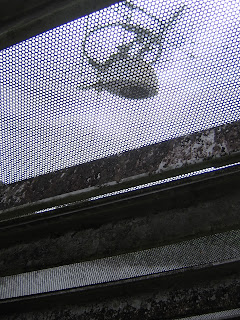I'll talk a bit about the telescope and my own visit, with a few photos, below the jump.
The first view of the telescope, around 4:00, is of the space under it. I've been there, and it's a very peculiar space — the telescope itself is a fairly fine mesh, so that water drips down from it and there is partial shade underneath. It's rather like the lower layers of the rainforest surrounding the telescope, but the ecology there is apparently unique. Walking around down there feels weird, firstly because it's a surprisingly long walk — three or four turns, each about a kilometer long, around the old sinkhole before you reach the flat bottom — and second because the ceiling curves up and away. It's never more than about five meters overhead, but there's a weird sort of inverted horizon that gets in the way of seeing any great distance. The dish is held in position by cement anchors and cables that reach down every few meters. At the bottom there is a large opening in the dish, through which heavy equipment can be hoisted up to the receiver room.
On top of the telescope there is a cable car out to the triangular structure supporting the azimuth arm, but we took the catwalk. It feels very Indiana Jones, and I was not reassured by our guides insistence that no more than two of us be on it at any given moment. I'm not generally afraid of heights — in fact I quite like them — but it was a little dizzying to look down. It's a long way down, and the structure you stand on is suspended from three pylons, so there's no support directly below. And yet the platform can be kept in position to within a few centimeters even in quite high winds. I imagine they don't try to observe during hurricanes, but the telescope survives them.
The actual receivers are in a three-storey-high dome that serves to focus the incoming rays back to a point after being reflected from the spherical main dish. This dome moves back and forth on a rotating azimuth arm so that the telescope can see about a forty-degree circle of sky. Over the course of a day, this lets the telescope see a band stretching from about declination zero to about forty degrees. To get out to the dome, you climb down a ladder inside the azimuth bearing, then hop out through some girders onto the arm. It looks like there are some arm positions where you can't really get from one to the other, and, more disturbingly, there's no safety interlock — it's up to you to make sure you're not in it when the telescope moves. Granted, it doesn't move that fast — maybe five minutes to turn 180 degrees? — but the arm is so massive it wouldn't even notice if you were in the way. The jump from the arm to the dome is much less alarming, just a step from a walkway to a platform on the dome. Inside the dome you can enter the receiver room, where there is a large turret that can rotate the various receivers into the focus. I was amused to note that the receiver I usually use — the L-band wide — is literally held together with duct tape and bungee cords. Works well, though.
Altogether the telescope is an amazing machine. The physical structure hasn't changed all that much, apart from a resurfacing, but the electronics are constantly being improved; for example there is now a multi-beam receiver that gives you seven whole pixels at a time! There are things you need another telescope for, but when you need the highest possible sensitivity, there's nothing that can replace Arecibo. Unfortunately, its funding is under significant threat right now. Let's hope we can save it.













No comments:
Post a Comment